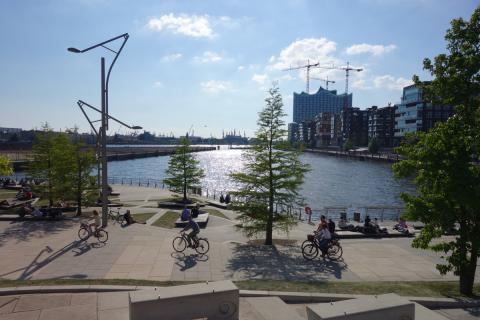
"Inside every German there is a touch of the wild-haired Beethoven grappling against impossible odds to express the inexpressible." - Nationalism & Identity, a quote from the Xenophobe's guide to Germans.
Hamburg, Germany's second largest city and the third largest port city in Europe, received the European Green Capital award in 2011. This title was awarded to Hamburg based on its wise use of natural resources, innovative policy for 'responsible growth' and its ambitious goals for achieving specific environmental best practices by 2020, such as its plan to cut CO2 emissions by 40%! In addition, it has more green spaces and urban parks than any other city in Germany.
While in Hamburg, we visited the HafenCity development. This brownfield sustainable re-development stretches 10.5km along the historically industrial sector of Hamburg’s southern waterfront, and is currently one of the largest inner-city developments in the world.
How does the HafenCity development compare to other developments we have visited?
While in Hamburg, we learned that Germany often looks to Denmark as a leader in re-development. Reflecting on Denmark's development achievements, however, we noticed Ørestad (Denmark) didn't exhibit the same success as HafenCity (Germany). Ørestad is a prime example of the way top-down approaches to unregulated, urban development projects can create distance, hierarchy and shift cultural norms within a district or city centre.
In contrast, during our visit to HafenCity, we found that the project experiences much more success because it follows specific regulations to ensure that it is well integrated into the city centre and reflects the interests of the community. The development’s colour schemes, architectural design, heights, building phases and funding sources are all regulated, with the rest of the details at the developer’s discretion. As one of the planners involved in the project told us, the goal was to build a neighbourhood, not just to build buildings.
There is also a significant economic difference between HafenCity and Ørestad. HafenCity is 100% city-funded, where the developers are paid by the city and therefore do not depend on the direct profit margin of the residential units. Ørestad built a metro line connecting it to the city center, expecting that this would encourage businesses and residences to pop up. This plan backfired and, as a result of poor planning and lack of city funding, Ørestad is now in debt and relies heavily on its massive “Field's” mall for continuous outside funding.

The HafenCity and Ørestad developments also differ in terms of their social dimensions and public involvement. The HafenCity development incorporated the needs of resident groups such as children, folks with disabilities, students, musicians, religious groups, seniors, women, and young families. HafenCity has had particular success because of its multi-use plan to meet the needs of middle-class to upper class people. It has become a world-renowned place for comfortable residential housing, general offices, small business retail spaces, public events, education facilities and institutions as well as world class entertainment and cultural spaces to attract the broader community. On the other hand, the Ørestad development did not seek out public input or implement basic necessities for making the location more viable for non-vehicle owners. It is clear that extensive public consultation demonstrated by HafenCity is more likely to create a successful development than the top-down, behind-doors approach of Ørestad.
What tactics is HafenCity using to adapt to climate change?
Flood risks in HafenCity are significantly higher than elsewhere in Hamburg, due to the close proximity to the water. The regular 4 meter tides haven’t been a significant problem in the past, but with rising sea levels tides could rise to 7 meters in the next decades, which would have drastic implications for the surrounding community. Increased frequency and magnitude of storm surges (thanks to climate change) also pose major threats to HafenCity, which has had to plan for potentially devastating flooding.
Some solutions to these hazards in HafenCity include:
- Elevating all streets in HafenCity by 4 meters
- Protecting the inner city using a dyke
- Installing concrete foundations in all buildings for extra protection from slides, subsidence and increased flooding
- Installing flood gates for promenade-level businesses that will inevitably experience periodic flooding; this solution enables the businesses to remain open during the flood. You can sit by the window sipping your cappuccino as you watch the water rise!
HafenCity prides itself as a place that urban planners from all over Europe can model for development strategies. We are curious to see how this harbour community progresses and grows within its inner-city location!

